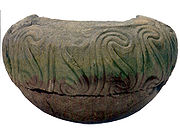
Butmir Culture
Encyclopedia

Butmir
Butmir is a neighborhood of Ilidža in the Sarajevo Canton of Bosnia and Herzegovina. It is a small but fairly important and well-known neighborhood of several thousand people.Geographically, the Butmir region is very rich in flint...
, near Ilidža
Ilidža
Ilidža is a town and municipality in central Bosnia and Herzegovina. It has a metro population of 157,654, making it the 7th largest city in the country. Ilidža is the chief suburb of Sarajevo. It is famous for the natural beauty of its surroundings and historical tradition dating back to...
, Bosnia and Herzegovina
Bosnia and Herzegovina
Bosnia and Herzegovina , sometimes called Bosnia-Herzegovina or simply Bosnia, is a country in Southern Europe, on the Balkan Peninsula. Bordered by Croatia to the north, west and south, Serbia to the east, and Montenegro to the southeast, Bosnia and Herzegovina is almost landlocked, except for the...
, dating from the Neolithic
Neolithic
The Neolithic Age, Era, or Period, or New Stone Age, was a period in the development of human technology, beginning about 9500 BC in some parts of the Middle East, and later in other parts of the world. It is traditionally considered as the last part of the Stone Age...
period. It is characterized by its unique pottery, and is one of the best researched European cultures from 2600-2400 BC.
History
The Butmir culture was discovered in 1893, when Austro-HungarianAustria-Hungary
Austria-Hungary , more formally known as the Kingdoms and Lands Represented in the Imperial Council and the Lands of the Holy Hungarian Crown of Saint Stephen, was a constitutional monarchic union between the crowns of the Austrian Empire and the Kingdom of Hungary in...
authorities began construction on the agricultural college of the University of Sarajevo
University of Sarajevo
The University of Sarajevo is the first university in Bosnia and Herzegovina. It was originally established in 1531 as a Madrasah or Islamic Law college, with a modern university being established and expanded on top of that in 1949. Today, with 23 faculties and around 55,000 enrolled students, it...
. Various traces of human settlement were found dating to the Neolithic period. Digs were begun immediately, and lasted until 1896.
The finds caused interest among archaeologists worldwide. They were largely responsible for the International Congress of Archaeology and Anthropology being held in Sarajevo
Sarajevo
Sarajevo |Bosnia]], surrounded by the Dinaric Alps and situated along the Miljacka River in the heart of Southeastern Europe and the Balkans....
in August 1894. The most impressive finds were the unique ceramics, which are now found in the National Museum of Bosnia and Herzegovina
National Museum of Bosnia and Herzegovina
The National Museum of Bosnia and Herzegovina is located in central Sarajevo, the capital of Bosnia and Herzegovina. It was established in 1888, having originally been conceived around 1850...
.
Certain characteristics of the Butmir pottery designs (e.g. its resemblance with Kamares
Kamares
Kamares may refer to the following places:in Greece:*Kamares, Achaea, a town in the northern part of Achaea*Kamares, Crete, a village in the southern part of the Heraklion peripheral unit in southern Crete...
style Minoan pottery
Minoan pottery
Minoan pottery is more than a useful tool for dating the mute Minoan civilization. Its restless sequence of rapidly maturing artistic styles reveal something of Minoan patrons' pleasure in novelty while they assist archaeologists to assign relative dates to the strata of their sites...
) made some suggest a connection to the Minoan
Minoan civilization
The Minoan civilization was a Bronze Age civilization that arose on the island of Crete and flourished from approximately the 27th century BC to the 15th century BC. It was rediscovered at the beginning of the 20th century through the work of the British archaeologist Arthur Evans...
culture on Crete
Crete
Crete is the largest and most populous of the Greek islands, the fifth largest island in the Mediterranean Sea, and one of the thirteen administrative regions of Greece. It forms a significant part of the economy and cultural heritage of Greece while retaining its own local cultural traits...
. Of course this was during the same time that some suggested Troy
Troy
Troy was a city, both factual and legendary, located in northwest Anatolia in what is now Turkey, southeast of the Dardanelles and beside Mount Ida...
was found in the Neretva
Neretva
Neretva is the largest river of the eastern part of the Adriatic basin. It has been harnessed and controlled to a large extent by four HE power-plants with large dams and their storage lakes, but it is still recognized for its natural beauty, diversity of its landscape and visual...
river valley, and overwhelming modern opinion is that the Butmir people were a unique culture of their own in the Sarajevo area.
The culture disappeared during the Bronze Age
Bronze Age
The Bronze Age is a period characterized by the use of copper and its alloy bronze as the chief hard materials in the manufacture of some implements and weapons. Chronologically, it stands between the Stone Age and Iron Age...
, most likely conquered by the Illyrians
Illyrians
The Illyrians were a group of tribes who inhabited part of the western Balkans in antiquity and the south-eastern coasts of the Italian peninsula...
who settled the area at the time. The Illyrian tribe who occupied the area after them were the Daesitates.

